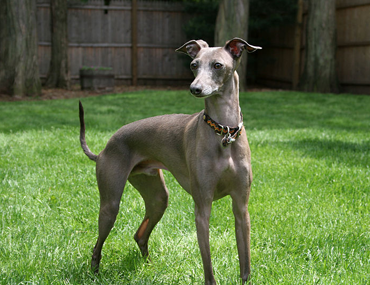Background:
The Italian Greyhound was popularized by Italian nobles during the renaissance, but evidence of his existence can be traced back over 2000 years to the artwork of the Mediterranean region. During the 17th century The Italian greyhound proved popular with English nobility, just as he had been in Italy. He was one of the few toy breeds during that time and continued to grow in number until the reign of Queen Victoria.
The Italian Greyhound was nearly stamped out after World War II. Largely because breeders tried to breed them smaller resulting in unhealthy dogs with bad teeth and bulging eyes. Fortunately, the few Greyhounds who lived in America were unaffected by this quest for a smaller greyhound and were able to revitalize the breed.
Sizing up:
- Weight: 7 to 15 lbs.
- Height: 13 to 15 inches
- Coat: Short, smooth
- Color: Any color except brindle and black/tan
- Life expectancy: 12-15 years
What’s the Italian Greyhound like?
The Italian Greyhound is a small bundle of athleticism. He loves to play both indoors and out, and one of his favorite hobbies is to run. On cold days when he would rather stay indoors, he can play with a plush toy. The Italian Greyhound is especially partial to tug of war. If you fail to exercise the IG he’ll take his frustration out on your furniture and floors. On the other hand, a tired Italian Greyhound will be happy to curl up in your lap.
The Italian Greyhound is a family dog. He will be great with older kids, who know how to be gentle with him. The IG isn’t recommended for small children because he is somewhat fragile and easily injured. He will also be reserved around strangers and is likely to bolt at any sign of hostility. Early socialization is the key to keeping your IG in the same room as a new acquaintance, he might never trust them but he shouldn’t run away either.
The IG is smart but has a short attention span and his own ideas about what’s right and wrong. Training can be difficult but patience and consistency will always pay off in the end.
Health:
As with any breed there are conditions to watch for in the Italian Greyhound:
- Epilepsy
- Cataracts
- Legg-Perthes disease
- Luxating patella
- Periodontal disease
- Hyperthyroidism
- Von Willebrand’s disease
- Progressive retinal atrophy
The Italian Greyhound might also break bones easier than other breeds.
Takeaway points:
- The Italian Greyhound can be fragile and isn’t recommended for small children.
- The Italian Greyhound needs to be exercised every day.
- The Italian Greyhound is intelligent and can be challenging to train.
If you have any questions or concerns, you should always visit or call your veterinarian – they are your best resource to ensure the health and well-being of your pets.
